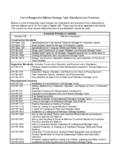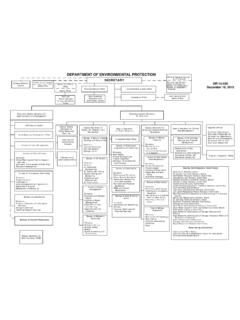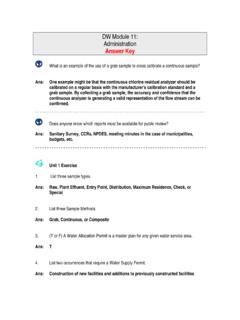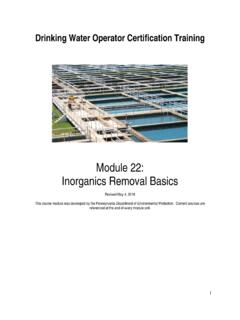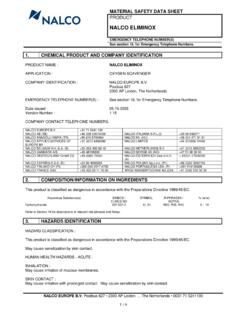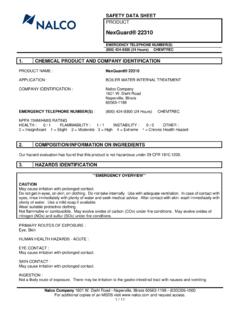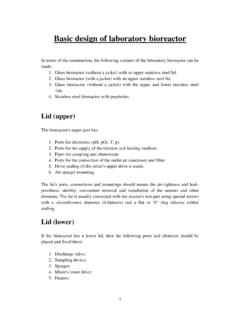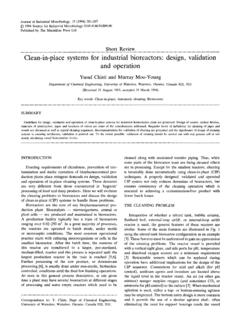Transcription of 89 Membrane Bioreactor (MBR) 89.1 General
1 PROPOSED DESIGN STANDARDS Membrane BIOREACTORS. 89 Membrane Bioreactor (MBR). General Membrane Bioreactors (MBR) combine conventional biological treatment processes with Membrane filtration to provide an advanced level of organic and suspended solids removal, along with the capabilities of advanced level nutrient removal in wastewater. This process may be used to accomplish carbonaceous and/or nitrogenous oxygen demand reductions. The design should be based on experiences at other facilities and should meet the applicable requirements under Sections 40, 60, and 80. This chapter contains criteria for low-pressure, vacuum, and gravity ultrafiltration or microfiltration Membrane bioreactors.
2 Typical Membrane system configurations include hollow fiber, tubular, or flat plate. Any other Membrane system configuration should be considered innovative treatment technology and conduct a pilot study. Pretreatment General a. Pretreatment is critical in MBR plant design to ensure adequate protection of membranes from physical damage. All MBR systems require fine screening and grit removal to prevent Membrane damage from abrasive particles common in influent sewage. b. Removal of fibrous or stringy material is also important. This material can become entangled and wrap around the hollow fibers or stuck within the gaps between Membrane flat plates.
3 This can plug the Membrane scour aeration systems leading to problems with operation of and potential damage to the system. c. If the influent oil and grease concentration exceeds 100 mg/L, or if historic problems with fats, oils and grease (FOG) exist within the community, oil and grease removal may also be necessary to prevent membranes from being coated. Bar Screens A mechanically cleaned bar screen with a manually cleaned emergency bypass bar screen or self-cleaning screening device should be provided. Bar screens should meet provisions of Section Grit Removal Pre-Draft/Page 1. PROPOSED DESIGN STANDARDS Membrane BIOREACTORS. a. Permanent grit removal facilities meeting the requirements of Section 53.
4 Should be provided for combined sewer systems and sewer systems receiving substantial amount of grit. b. If a plant serving a separate sewer system is designed without grit facilities, consideration shall be given to possible damaging effects on pump, comminutors, other preceding equipment, and the need for additional storage capacity in treatment units where grit is likely to accumulate. Primary Clarification Primary clarification must be considered for all plants. Proposals that do not include primary clarification should justify why primary clarifiers are not practical due to facility size constraints or limited benefit in comparison to the cost of handling primary solids.
5 Flow Equalization Influent flow equalization shall be considered for all MBR systems. Flow equalization should meet requirements of Section 55. Fine screens a. Location Fine screens should be located downstream of primary clarifiers. b. Design 1. Coarse screens followed by fine screens may be used to minimize the complications of fine screening due to high flow restrictions and increased solid waste handling 2. Fine screens should be rotary drum or traveling band screen with either perforated plate or wire mesh 3. Fine screens should have an opening size between mm mm for hollow-fiber and tubular membranes, or mm screening for flat plate membranes.
6 C. Number of Units 1. A minimum of two fine screens should be provided, with each unit being capable of independent operation. Pre-Draft/Page 2. PROPOSED DESIGN STANDARDS Membrane BIOREACTORS. 2. Capacity should be provided to treat peak design flows with one unit out of service. d. Electrical Fixtures and Controls Electrical fixtures and screening areas where hazardous gases may accumulate should meet the requirements of the National Electric Code for Class I, Division 1, Group D locations. e. Servicing 1. Hosing equipment should be provided to facilitate cleaning. 2. Provisions should be made for isolating or removing units from location for servicing.
7 Tank (Reactor) Design Capacities and Loadings a. The design sludge retention time (SRT) should be at least 10 days but no more than 25 days. An SRT outside this range may be acceptable if supported by a pilot study. b. The design hydraulic retention time (HRT) should be between 6 hours and 15 hours. c. Organic loadings for reactors not required to provide biological nutrient removal should be in accordance with Section d. Organic loadings for reactors required to provide biological nutrient removal should be based on one of these models for nutrient removal: Modified Ludzak-Etinger (MLE);. Bardenpho;. Modified University of Cape Town (MUCT);or An alternative method approved by the Department e.
8 The food to microorganism (F/M) ratio for the reactors should not be greater than for plants requiring nitrification and for plants not requiring nitrification. Greater ratios may be accepted, if justified by a pilot study. f. Bioreactor MLSS concentration should be in the range of 4,000 mg/L to 10,000 mg/L. Other values may be accepted, if justified to the Department. Pre-Draft/Page 3. PROPOSED DESIGN STANDARDS Membrane BIOREACTORS. g. Membrane tank MLSS concentration should be in the range of 4,000 mg/l to 15,000 mg/l. Other values may be accepted, if justified to the Department. Arrangement of Tanks General Tank Configuration a. A system designed for enhanced nutrient removal (ENR) should include an isolated tank or baffled zone for anoxic treatment, anaerobic treatment, or both.
9 B. A facility designed for nitrogen or biological nutrient removal should contain a deoxygenation basin, a larger anoxic basin, or another method approved by the Department for decreasing dissolved oxygen concentration, if the recycled activated sludge is returned to an anoxic or anaerobic basin. c. An advanced nutrient removal system should be designed with recycle rates sufficient to sustain the designed mixed liquor concentrations in both the aeration and anoxic basins; typically totaling 600% or more of the influent flow. d. Facilities without advanced treatment should be designed with recycle rates sufficient to sustain the design mixed liquor concentrations; typically from 300% to 500% of the facility's influent flow.
10 E. A system with a peak flow rate that is greater than times the average daily flow should use equalization storage, or reserve Membrane capacity to accommodate the higher peak flow. f. An inner-tank valve should be provided for refilling tanks when one is taken out of service. The valve should be placed near the inlet side of the tank(s) near floor level. g. Each reactor should include a dewatering system and be provided with inter-reactor overflow to another aeration tank or a storage tank. h. The hydraulic grade line calculations should consider, operating depth changes, operation during stream flooding elevations, future plant expansions, and potential for treatment units or pumps to be out of service.
